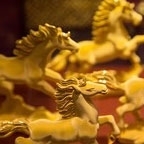
A 500-tonne gap in China’s gold consumption data is fuelling talk that the central bank took advantage of weak prices last year to bulk up its holdings of the precious metal.
中国黄金消费数据中存在一个500吨的缺口,这一信息支持了有关中国央行去年利用金价走弱之机增持黄金的说法。
The last time the Chinese central bank said it increased its gold holdings was nearly five years ago, in early 2009. Officials have since then repeatedly insisted that they do not view gold as a useful asset for diversifying the country’s $3.8tn mountain of foreign currency reserves.
中国央行上次公示增加黄金储备,还是在将近5年前的2009年初。自那以后,中国官员一直坚称,他们不认为黄金资产能对中国3.8万亿美元的海量外汇储备起到使其多元化的作用。
But the latest official figures show that China imported and produced far more gold in 2013 than its citizens bought. This chasm suggests that the central bank was a buyer in the gold market last year in spite of its protestations to the contrary, say analysts.
但最新官方数据显示,2013年中国进口和生产的黄金远远超过中国公民的购买量。分析师表示,这一巨大缺口意味着,去年中国央行在黄金市场上扮演了买方角色——尽管其声明的内容与此相反。
The China Gold Association published data on Monday showing that Chinese demand for gold surged 41 per cent to 1,176 tonnes last year, making it all but certain that China overtook India as the world’s biggest consumer of bullion.
周一,中国黄金协会(China Gold Association)发布的数据显示,去年中国的黄金需求量猛增41%,至1176吨。中国因此几乎肯定已超越印度,成为世界最大的黄金消费国。
Yet Chinese import and production volumes were even stronger. China imported 1,158 tonnes of gold via Hong Kong, more than double its 2012 total. Domestically, production of bullion rose 6 per cent to 428 tonnes. On top of that, China also imported gold directly through Shanghai, though these numbers have not been published.
然而,中国的黄金进口量和产量增势更为强劲。中国经由香港进口了1158吨黄金,是2012年进口总量的两倍多。中国国内的黄金产量增长了6%,至428吨。除此以外,中国还经由上海直接进口了黄金,尽管相关数据并未公布。
Adding up the reported and estimated figures, Na Liu of CNC Asset Management calculated that China’s “apparent gold consumption” exceeded 1,700 tonnes in 2013, more than 500 tonnes higher than reported.
CNC资产管理公司(CNC Asset Management)的刘纳把公布的和估计的数字加总到一起,得出的计算结果是,2013年中国“貌似可能的黄金消费量”超过1700吨,比公布的数字高出逾500吨。
“We would not be surprised to hear the People’s Bank of China announce a new, significantly higher figure, if it chooses to do so,” Mr Na said. The PBOC has said that its gold reserves have been steady at 1,054 tonnes since April 2009.
刘纳表示:“如果中国央行选择公布新的黄金储备数据,而这一数据大幅升高,我们不会感到意外。”中国央行表示,2009年4月以来其黄金储备一直稳定在1054吨。
But central bank buying is only one of the explanations for the chasm between China’s apparent and actual gold consumption.
不过,就中国看上去的黄金消费量与官方公布的消费量间的巨大缺口而言,中国央行的买入行为只是其中的一种解释。
Liu Xu, an analyst with Capital Futures in Beijing, said that companies in the jewellery market may have also built up their gold stocks and that commercial financial institutions such as banks have also been adding to their holdings. Neither would show up in the gold demand data, which measures final consumption.
北京首创期货(Capital Futures)分析师刘旭表示,珠宝市场的企业可能也增加了黄金库存,而银行之类的商业金融机构也一直在增持黄金。以上两者都不会出现在黄金需求数据中,因为这一数据考察的是黄金的最终消费。
“It’s not only about increases in official holdings. It’s more accurate to say that every level of society, from individuals up to banks, has been allocating more to gold,” Mr Liu said. “Wealth is expanding and people have limited investment channels, so gold is attractive.”
刘旭表示:“这个问题不仅仅与官方增持有关。更准确的说,从个人到银行的社会各个层面都在增持黄金。人们的财富在增长,投资渠道却十分有限,因此黄金是很有吸引力的。”
Moreover, the Chinese jewellery industry has also grown quickly and exports of finished products would not necessarily be captured by the gold data.
此外,中国珠宝业的发展也十分迅速,黄金成品的出口未必在黄金数据中得到体现。
Speculation has been mounting in recent months that the Chinese central bank might announce updated figures for its gold holdings, but Mr Liu said the recent rebound in prices could lead it to remain quiet, for fear of sparking a jump in the market.
最近几个月,投机活动不断加剧,为此中国央行可能会公布最新的黄金储备数据。但刘旭表示,金价近期的反弹可能会令中国央行保持沉默,以免引发金价暴涨。
Even if the Chinese central bank’s gold holdings were twice as large as officially reported, they would still account for roughly 2 per cent of the country’s official reserves, well below the norm in more developed economies.
即使中国央行的黄金储备量是官方先前公布的数字的两倍,其在中国官方储备中也仍然只占2%左右,而这一比例远低于较发达经济体的常见水平。


